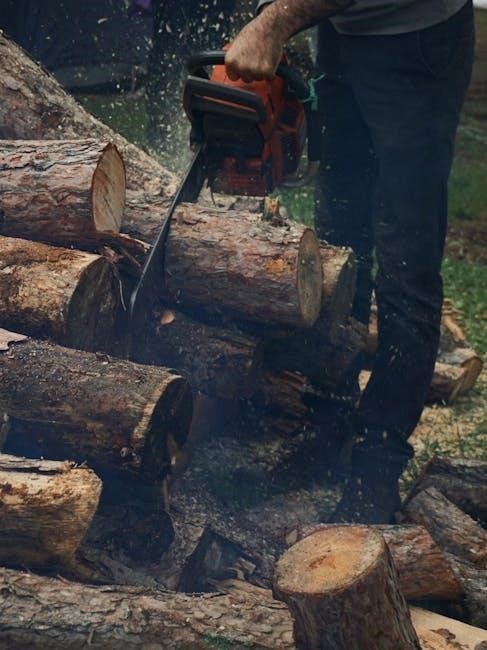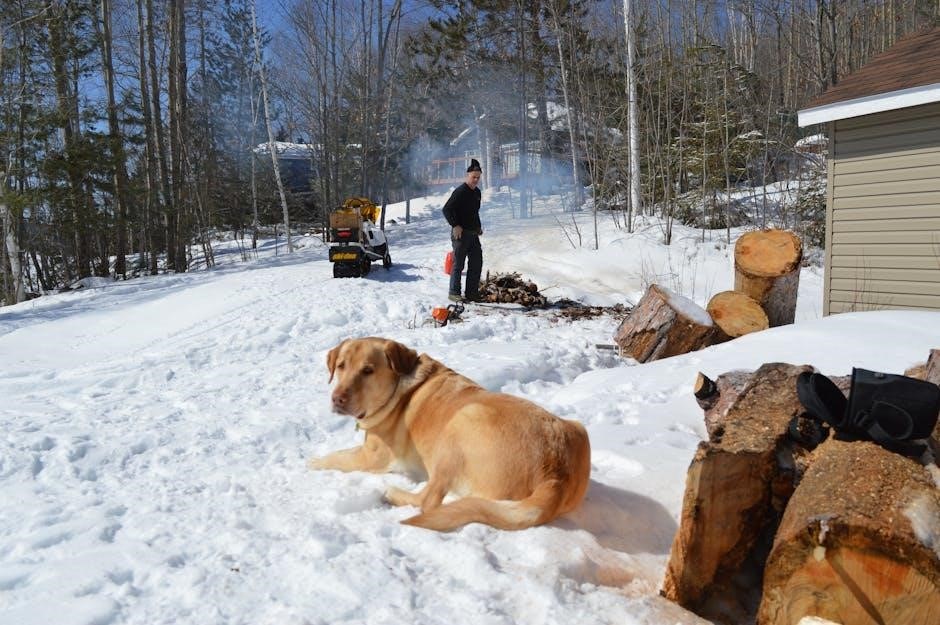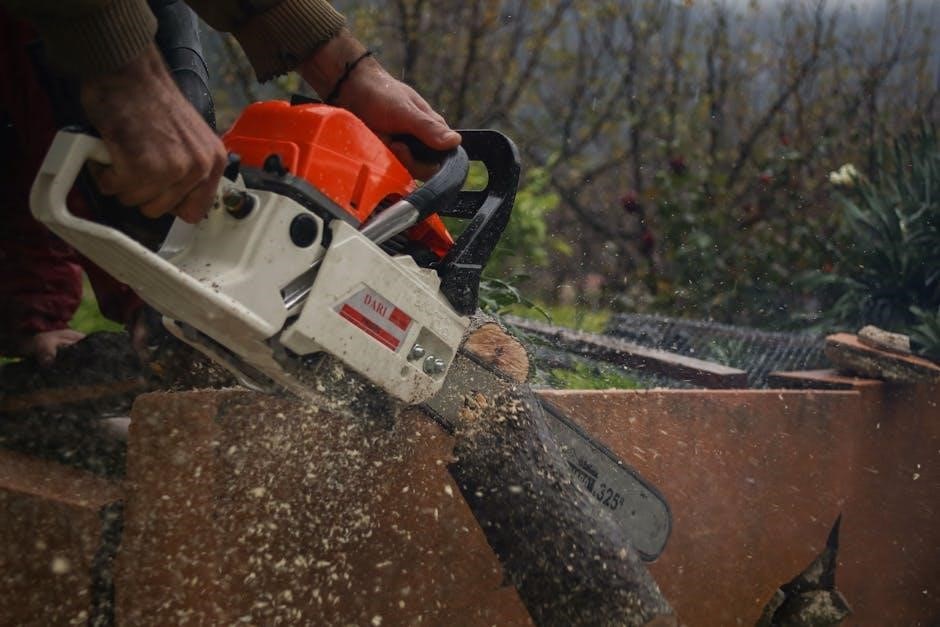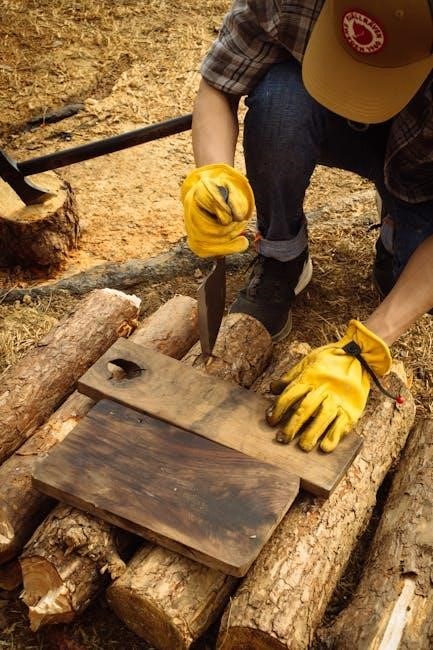
chainsaw firewood length guide
Cutting firewood efficiently requires precision and consistency․ A chainsaw is a powerful tool, but achieving uniform lengths can be challenging without the right techniques․ This guide explores practical methods for measuring and cutting firewood accurately, ensuring safety, efficiency, and optimal results for various uses, from fireplaces to camping․ Discover how to leverage your chainsaw’s bar length, specialized tools, and simple marking techniques to streamline the process and achieve professional-quality firewood․
Importance of Consistent Firewood Length
Consistent firewood length is crucial for efficiency, safety, and practicality․ Uniform pieces ensure even burning in fireplaces and stoves, optimizing heat output and reducing waste․ Inconsistent lengths can lead to uneven combustion, safety hazards, and difficulty in stacking․ Properly sized logs fit better in storage spaces, making organization easier and reducing mess․ Additionally, consistent lengths enhance safety by preventing oversized logs from causing accidents during handling or burning․ This precision also streamlines the cutting process, saving time and effort․ Ultimately, consistent firewood length ensures a more efficient, safer, and neater firewood management system for home or outdoor use․
Understanding Chainsaw Bar Length for Firewood Cutting
The chainsaw bar length determines the maximum log size you can cut․ Common lengths range from 14 to 20 inches, with longer bars handling larger logs more efficiently․ Maneuverability decreases with longer bars, so choose based on your firewood needs and cutting environment․
Chainsaw Bar Length and Its Impact on Firewood Size
The length of a chainsaw bar significantly influences the size of firewood you can cut․ A bar length of 14-16 inches is typically sufficient for most firewood tasks, allowing precise cuts for standard log sizes․ Using the bar as a measuring tool ensures consistent lengths, with marks or indentations guiding accurate cuts․ However, longer bars, such as 18-20 inches, enable cutting larger logs but may reduce maneuverability․ Choosing the right bar length balances efficiency and control, ensuring optimal firewood size for stoves, fireplaces, or outdoor use․ Proper bar selection enhances safety and productivity, making it a critical factor in achieving professional-quality firewood cuts․

Choosing the Right Chainsaw for Firewood Cutting
Selecting the right chainsaw involves considering bar length, power source, and size․ Gas-powered saws offer more power, while battery saws provide portability․ A chainsaw with a bar length of 14-18 inches is ideal for most firewood tasks, balancing maneuverability and cutting capacity․ Ensure the chainsaw matches your workload and log sizes for efficient cutting․ Proper selection enhances safety, precision, and productivity, making it crucial for achieving consistent firewood lengths․

Recommended Chainsaw Sizes for Firewood
For efficient firewood cutting, chainsaw bar lengths of 14-16 inches are ideal for most tasks, offering a balance between maneuverability and cutting capacity․ An 18-inch bar is suitable for larger logs, while smaller 12-inch models work well for thinner branches․ Gas-powered saws are recommended for heavy-duty use, while battery-powered options provide portability for smaller jobs․ Choosing the right size ensures precise cuts, reduces fatigue, and enhances safety․ Match the chainsaw size to your log diameters and workload for optimal performance․ Proper sizing is key to achieving consistent firewood lengths and streamlining the cutting process․

Measuring Techniques for Consistent Firewood Length
Consistent firewood lengths are essential for efficient burning․ Use the chainsaw bar, roll markers, or manual tools like chalk to ensure precise cuts and uniform sizes, enhancing safety and efficiency․
Using the Chainsaw Bar as a Measuring Tool
The chainsaw bar itself can serve as a practical measuring tool for consistent firewood lengths․ If the bar is 16 inches long, for example, it can be used as a direct guide for cutting logs to that size․ To mark the length, rev the engine and lightly touch the chainsaw tip to the log, creating a small indentation․ This method eliminates the need for additional tools and ensures accuracy․ While it’s cost-effective and simple, it can be slower for large quantities․ For longer bars, use a marker to indicate the desired length, providing a clear reference point for precise cuts without extra equipment․
Roll-Type Firewood Markers for Accuracy
Roll-type firewood markers are an excellent solution for achieving consistent log lengths quickly․ These devices feature a wheel that rolls along the log, dispensing paint at precise intervals to mark cutting points․ This method is faster than using the chainsaw bar alone, allowing you to process more wood efficiently․ The Mingo firewood marker, available on Amazon, is a popular choice for its reliability and ease of use․ Simply roll the tool along the log, mark the desired length, and cut with your chainsaw․ While highly effective, some users find the wheel can be cumbersome when navigating around log piles, but it remains a top option for accuracy and speed․
Measuring Rods and Attachments for Chainsaws
Measuring rods and attachments for chainsaws provide a practical solution for achieving consistent firewood lengths․ These tools attach directly to the chainsaw, allowing you to measure and cut logs without premeasuring․ The ARC measuring stick, available on Amazon, is a popular option that attaches to the saw, enabling quick and accurate cuts․ While these attachments are convenient, they can sometimes obstruct movement around the log pile․ Despite this, they remain a valuable tool for those seeking precision and efficiency in their firewood cutting process․ This method ensures consistent results while minimizing the need for additional measuring tools․

Manual Marking with Chalk or Axe
Manual marking with chalk or an axe offers a simple, cost-effective method for achieving consistent firewood lengths․ By marking the desired cut points directly on the logs, you can ensure uniform sizing․ Chalk is a quick and easy option, allowing you to clearly define where to make each cut․ Alternatively, an axe can be used to create small notches or indentations at the required lengths․ For added convenience, some users mark their axe handle with specific measurements, enabling quick and accurate referencing․ While this method takes more time than specialized tools, it provides a practical solution for those preferring minimal equipment․ The result is neatly sized firewood, ideal for stacking and burning․
Safety Practices for Cutting Firewood with a Chainsaw

Always wear protective gear, including gloves, safety glasses, and a helmet․ Ensure logs are securely positioned and supported to prevent rolling or shifting during cutting․ Carry the chainsaw with the engine off and bar facing backward for safe handling․ Maintain a firm stance and keep bystanders at a safe distance to avoid accidents․ Proper log positioning and support are critical to preventing injuries and ensuring controlled cuts․ Follow these practices to minimize risks and ensure a safe firewood-cutting experience․
Protective Gear and Precautions
Safety is crucial when cutting firewood with a chainsaw․ Always wear protective gear, including a helmet, safety glasses, gloves, and chainsaw chaps, to minimize injury risks․ Ensure logs are stable and supported to prevent accidental movement․ Carry the chainsaw with the engine off, bar facing backward, and muffler away from your body․ Maintain a firm stance and keep bystanders at a safe distance․ Avoid overreaching or cutting near obstacles․ Regularly inspect the chainsaw for sharpness and proper function to reduce kickback risks․ Proper precautions ensure a safer and more controlled cutting experience, protecting both the operator and others nearby․
Proper Log Positioning and Support
Proper log positioning and support are essential for safe and efficient firewood cutting․ Logs should be placed on a stable, flat surface or sawhorse to prevent rolling or movement during cutting․ For logs supported along their entire length, cut from the top (overbucking), avoiding contact with the ground․ If supported on one end, start with an underbuck cut from the bottom, then finish with an overbuck cut from the top․ Ensure logs are secure and balanced to maintain control during the cut․ Proper positioning reduces the risk of accidents and ensures accurate, consistent cuts․ Always prioritize stability to enhance safety and efficiency while cutting firewood․

Step-by-Step Guide to Cutting Firewood
Measure logs using the chainsaw bar or a marker, position securely on a sawhorse, and cut from the top (overbuck) or bottom (underbuck) for consistent lengths․

Overbucking and Underbucking Techniques
Overbucking involves cutting from the top of a horizontally supported log, preventing the saw from digging into the ground․ This method reduces chain wear and enhances safety․ Underbucking, cutting from the bottom, is ideal when the log is supported on one end, minimizing the risk of the saw binding․ Both techniques ensure precise cuts and consistent firewood lengths, optimizing efficiency and safety during the process․ Mastery of these methods is essential for achieving professional-quality results and maintaining equipment longevity․ Proper technique selection depends on log positioning and support, ensuring a smooth and effective cutting experience every time․ Accuracy and control are key to successful firewood preparation․

Optimal Firewood Lengths for Different Uses
Firewood length varies by application, ensuring efficiency and safety․ Standard lengths suit most needs, while specific uses may require adjustments for optimal performance and convenience․
Fireplace and Wood Stove Requirements
For fireplaces and wood stoves, firewood length should align with the appliance’s size and design․ Standard lengths typically range from 14 to 18 inches, ensuring efficient burning and proper fit․ Larger stoves may accommodate logs up to 24 inches, while smaller fireplaces work best with shorter pieces․ Consistent lengths promote even combustion, reducing waste and maximizing heat output․ Always measure logs to fit your specific stove or fireplace, as oversized wood can cause inefficiency or safety hazards․ Proper sizing ensures a cleaner, more controlled burn, enhancing overall performance and comfort during colder months․
Outdoor Camping and Fire Pit Needs

When preparing firewood for outdoor camping or fire pits, shorter lengths are often preferred for portability and ease of use․ Logs typically range from 12 to 16 inches, allowing them to fit easily into smaller fire rings or pits․ Consistent sizing ensures a steady burn, which is essential for cooking and warmth in outdoor settings․ For camping, consider cutting wood to varying lengths to accommodate different fire sizes and durations․ Using a chainsaw with a marked guide bar or a measuring rod can help achieve uniform lengths quickly․ This consistency also makes storing and transporting firewood more efficient, enhancing your outdoor experience․
Tools to Enhance Firewood Cutting Accuracy
Specialized tools like roll-type markers, measuring rods, and chalk or axe markings ensure precise firewood lengths; These devices simplify the process, improving consistency and efficiency while reducing effort․
Specialized Measuring Devices for Chainsaws
Specialized measuring devices, such as roll-type firewood markers and measuring rods, enhance accuracy when cutting firewood․ Roll-type markers dispense paint along the log, marking precise cutting points quickly․ Measuring rods attach directly to the chainsaw, allowing easy length gauging without pre-measuring․ These tools improve consistency, speed, and safety, ensuring uniform firewood lengths․ They are ideal for homeowners and professionals seeking efficient, professional-grade results․ While roll-type markers offer fast operation, measuring rods provide convenience, though they may obstruct movement․ Both options streamline the cutting process, reducing errors and saving time․ Investing in these tools ensures precise cuts and better-organized firewood stacks․
Cutting firewood with a chainsaw requires precision and consistency․ By using the right techniques, tools, and safety practices, you can achieve uniform lengths efficiently․ This guide has provided practical advice to help you master firewood cutting, ensuring optimal results for heating and outdoor use․ Always prioritize safety and precision to enjoy a well-organized and effective firewood supply․
Final Tips for Precise and Efficient Firewood Cutting
For precise and efficient firewood cutting, always maintain consistent lengths to ensure optimal burning and storage․ Use the chainsaw bar as a built-in measuring tool or invest in roll-type markers for accuracy․ Prioritize safety by wearing protective gear and properly supporting logs during cuts․ Regularly maintain your chainsaw to ensure smooth operation․ Double-check measurements before cutting to avoid waste․ Experiment with techniques like overbucking and underbucking for different log sizes․ Finally, stay organized by sorting and stacking firewood by length for a neat and functional supply․ These tips will help you achieve professional-quality results while saving time and effort․